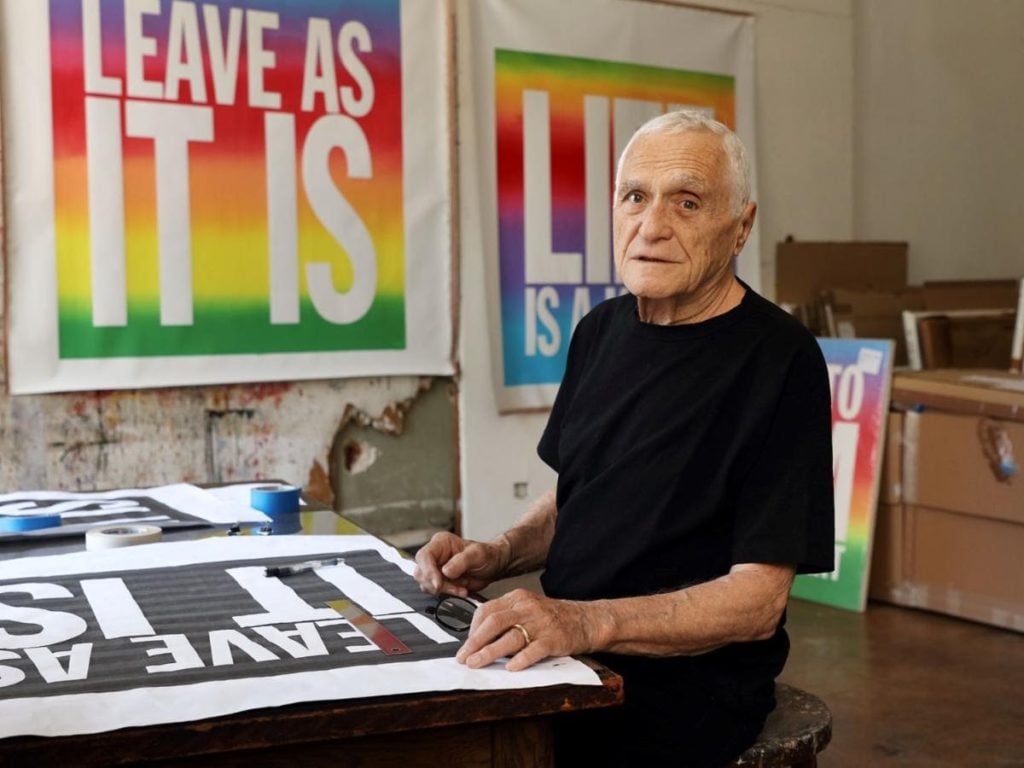People
The Beloved New York Artist, Beat Poet, and Warhol Film Star John Giorno Has Died
Over five decades, the New York artist and activist, who famously snoozed for Andy Warhol on film, expanded the definition of poetry.

Over five decades, the New York artist and activist, who famously snoozed for Andy Warhol on film, expanded the definition of poetry.

Javier Pes

The poet and text artist John Giorno, who was the silent protagonist of Andy Warhol’s epic “anti-film” Sleep, was always the star of his own show. Be it via a dial-up poetry service in the late 1960s or the late, bravura performances of his own poems, Giorno’s legendary status in the New York art world is assured.
Giorno, who has died on October 11 at age 82, was filmed in 2006 performing a poem he had written on his 70th birthday. Behind the camera was his husband, the Swiss artist Ugo Rondinone. The poem, called THANX 4 NOTHING, dealt with the death of friends and lovers, as well as sex, betrayal, and Giorno’s recurring periods of depression. He made often dark subject matter beguilingly life-affirming. Rondinone’s carefully choreographed, multi-screen installation behind his partner kept pace with Giorno’s theatrical delivery and his rhetorical twists and turns, immortalizing his charismatic stage presence.
Born in 1936 in New York, Giorno studied at the city’s Columbia University before briefly—and improbably—becoming a stockbroker. But reading Allen Ginsberg’s beat classic Howl in 1956 and meeting Warhol in 1962 changed all that. Giorno’s artistic and romantic relationship with Warhol resulted in the flim Sleep, a silent love letter that runs for more than five hours. However, Giorno was always much more than one of Warhol’s good-looking muses.

John Giorno at his studio, 2018. Photograph by Marco Anelli, courtesy of Sperone Westwater.
Giorno went on to push beat poetry into a new visual and high-tech direction. He created verbal collages based on appropriated texts, which evolved further thanks to friendship with the artist Robert Rauschenberg. Giorno’s pioneering work—he said he was trying to bring poetry up to speed with avant-garde visual art—led to the establishment of the groundbreaking nonprofit, Giorno Poetry Systems, and its 1967 Dial-a-Poem project. Subscribers were able to listen for free to recordings of poems at the end of a telephone by fellow poets and artists, such as Patti Smith, William S. Burroughs, and John Cage among others.
Giorno will also be remembered as a pioneering and courageous gay rights activists who, in 1984, turned his poetry nonprofit into the AIDS Treatment Project. As well as providing compassion, it also offered practical help and, occasionally, cash to men who were often treated as social outcasts in their dying days.
A sprawling retrospective in 2015 curated by Rondinone, called “I ♥ John Giorno,” underlined the poet’s achievements as a visual artist in his own right. Opening at the Palais de Tokyo in Paris, an expansive version of the solo show came to New York in 2017, where it spread across 13 venues. The US show featured Giorno’s paintings, sound installations, drawings, and videos, and, of course, Rondinone’s installation based on that celebrated Giorno reading of THANX 4 NOTHING.
The curator and director of New York’s Drawing Center, Laura Hoptman, wrote that it was an astonishing gesture on Giorno’s part to give his life’s work to his partner that became material for Rondinone’s own art. Perhaps only “an artwork as big as Manhattan” could do justice to Giorno’s gift, she said.
Last month, Giorno installed new work in his solo show “Do the Undone” at Sperone Westwater in New York. In a statement, his friend and the gallery’s co-founder Angela Westwater said: “When installing his last sculpture, NOW AT THE DAWN OF MY LIFE, John explained to me that he wanted the space to be meditative and ruminative, but not somber.” Reflecting on the subdued 2019 piece, which would be one of his last artworks, Westerwater added: “I think of this sculpture as an ode to his boundless creativity and zest for life.”